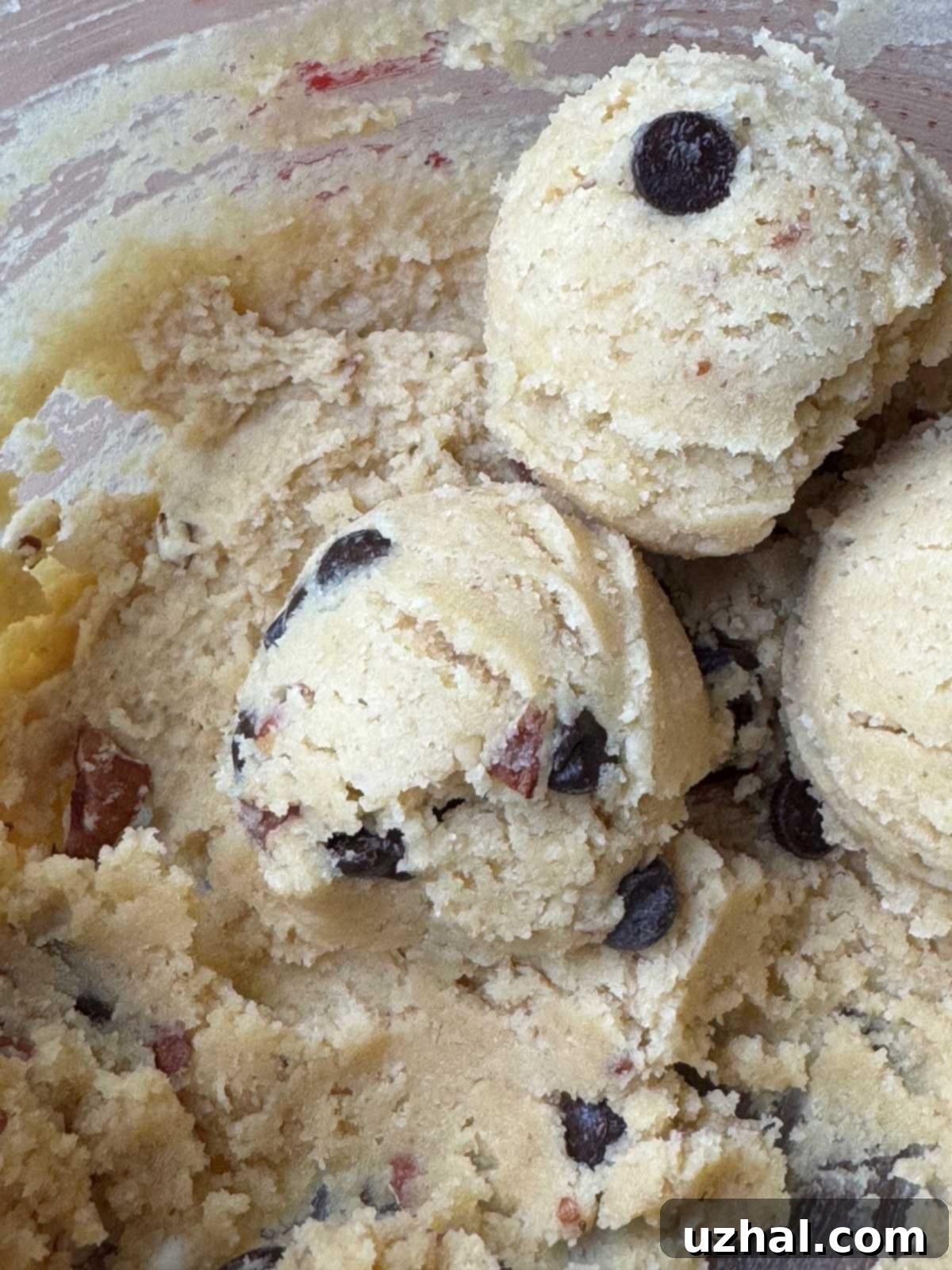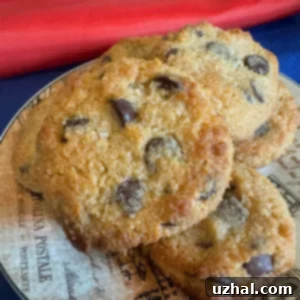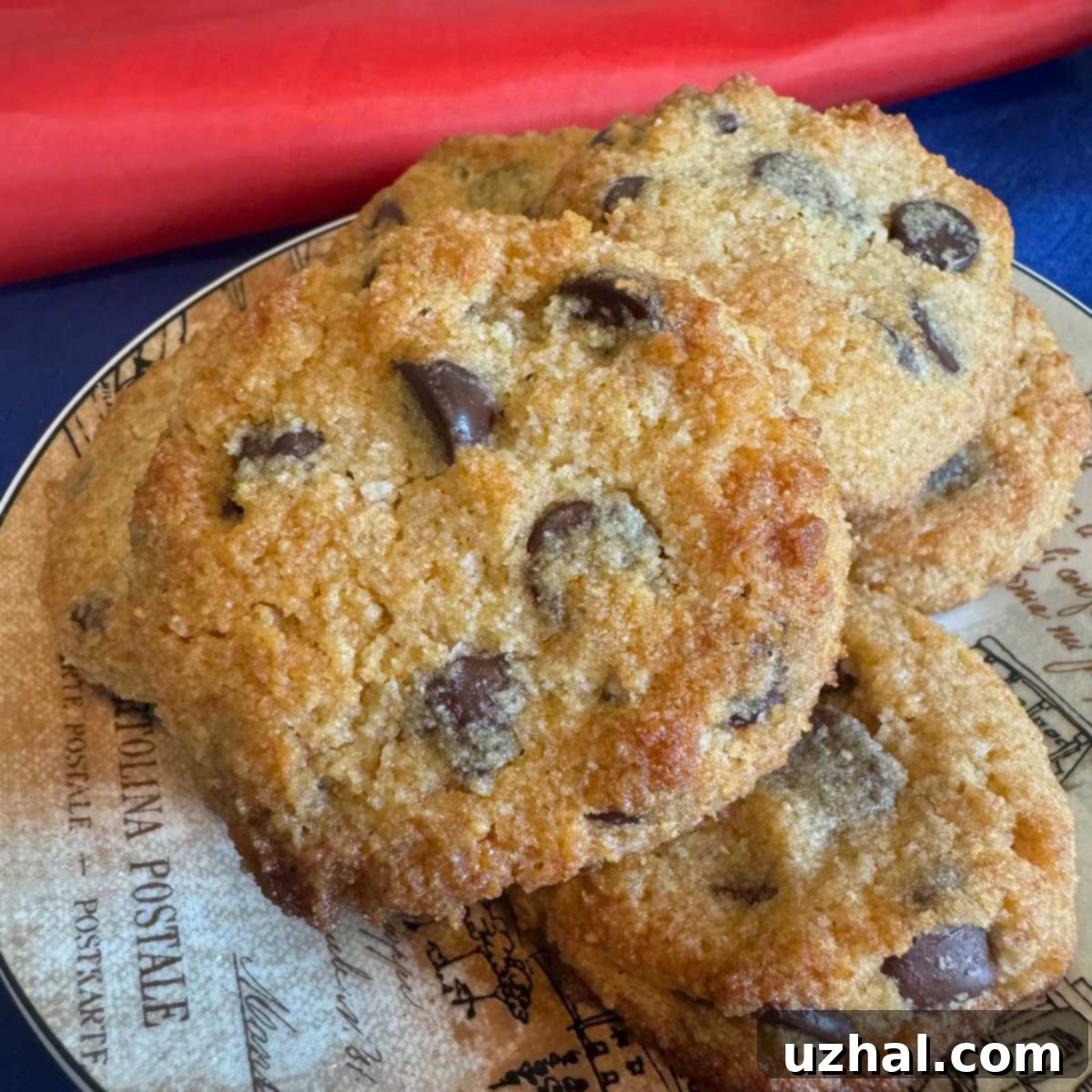Irresistibly Chewy Keto Chocolate Chip Cookies with Allulose: Your New Go-To Sugar-Free Treat
For many following a ketogenic lifestyle, finding a truly satisfying chocolate chip cookie can feel like an endless quest. While I genuinely love my Small Batch Keto Chocolate Chip Cookies, this particular recipe takes the experience to an entirely new level. These aren’t just good; they’re exceptionally good, especially if you crave that delightful chewiness that traditional cookies offer. We’re calling them Keto Chewy Chocolate Chip Cookies for a reason – the texture is absolutely divine, delivering a dense, pliable bite that’s often elusive in sugar-free baking. In my opinion, these allulose-sweetened chocolate chip cookies even surpass some conventional, sugar-laden versions in terms of flavor and texture, proving that healthy eating doesn’t mean sacrificing indulgence.
Achieving Perfect Chewy Keto Chocolate Chip Cookies with Allulose
Allulose has emerged as my undisputed favorite keto sweetener, primarily due to its remarkable lack of an aftertaste. This natural rare sugar offers a clean sweetness that truly elevates sugar-free desserts. However, allulose often presents a unique challenge in baking: it tends to make baked goods remarkably soft and somewhat cakey. This characteristic, while lovely in some applications, isn’t ideal for those who dream of a crispy or, in this case, a wonderfully chewy chocolate chip cookie.
But fear not, fellow keto bakers! Through careful experimentation, this recipe has cracked the code to harness allulose’s benefits while delivering a truly dense, satisfyingly chewy cookie. The secret lies in the strategic addition of coconut flour. Coconut flour is a highly absorbent ingredient, and in this recipe, it plays a crucial role in managing the extra moisture that allulose can impart. By absorbing this excess liquid, the coconut flour helps to bind the dough, prevent excessive spreading, and contribute to the dense, pliable texture we all love in a chewy cookie. As an added bonus, these cookies develop a subtle, delicate coconut flavor that beautifully complements the rich chocolate, enhancing the overall sensory experience without being overpowering.
Understanding Allulose and Cookie Browning
When you’re baking Keto Chewy Chocolate Chip Cookies with allulose, there’s an important characteristic to keep in mind: allulose significantly accelerates the browning process. Unlike many other keto sweeteners, allulose behaves more like regular sugar in terms of how it reacts to heat, contributing to a beautiful golden-brown exterior. However, this also means your cookies will brown much faster than traditional recipes or those made with erythritol blends.
These delicious cookies typically begin to brown noticeably within just 8 minutes in the oven. It’s crucial to keep a vigilant eye on them, especially during the last few minutes of baking. Ovens can vary widely, so what might be 8 minutes in one oven could be 10 or even 12 in another. Look for edges that are nicely golden, while the centers still appear slightly pale and soft. Over-baking can lead to a dry cookie, so pulling them out at the right moment is key to preserving their signature chewiness. Using parchment paper also helps prevent over-browning on the bottoms and makes for easier cleanup. If you notice them browning too quickly, consider reducing your oven temperature slightly or adjusting your baking time. This attention to detail will ensure you achieve perfectly baked, beautifully browned, and wonderfully chewy keto chocolate chip cookies every time.
Important Considerations: Allulose and Digestive Comfort
While allulose is a fantastic sweetener for keto baking, it’s important to acknowledge that it’s not suitable for everyone. Like some sugar alcohols, allulose can cause digestive discomfort in certain individuals, particularly when consumed in larger quantities. Symptoms can range from mild bloating and gas to more significant stomach upset.
This particular recipe for Keto Chewy Chocolate Chip Cookies uses 100% allulose as its sweetener, meaning each cookie contains a pretty substantial amount. If you are new to allulose or know you have a sensitive digestive system, it’s wise to approach consumption cautiously. Start with one cookie and observe how your body reacts before indulging further. Personally, given the unpredictable nature of these digestive effects, I would hesitate to serve a large batch of these cookies to a crowd of people whose dietary sensitivities I’m unaware of. It’s always best to be mindful and ensure your guests are comfortable with allulose before sharing these delightful treats. If you experience discomfort, consider reducing your portion size or exploring other keto-friendly recipes that use different sweeteners or a blend of allulose with other options in smaller quantities. Always consult with a healthcare professional or a registered dietitian if you have concerns about incorporating new ingredients into your diet, especially if you have pre-existing digestive conditions.
Visualizing the Dough: What to Expect in Keto Baking
Baking with keto-friendly ingredients, particularly almond flour and alternative sweeteners, can sometimes feel a bit like uncharted territory. The texture and behavior of keto dough are often quite different from what you might expect from traditional recipes made with all-purpose flour. It’s not uncommon for bakers to be surprised by the consistency, so managing expectations is crucial for a successful baking experience. To me, any cookie made with almond flour will inherently have a different character than a traditional wheat flour cookie. It will typically be denser, less elastic due to the absence of gluten, and have a slightly different mouthfeel.
That said, these differences are not a drawback; they are simply characteristics of keto baking. When you embark on making these Keto Chewy Chocolate Chip Cookies, know that the dough will be thick and slightly sticky, yet cohesive enough to scoop. It won’t have the same elastic stretch as a wheat flour dough, but it should hold its shape well. To give you a clear reference point and ensure you’re on the right track, here’s what the dough should look like. Understanding this visual cue can help prevent any worries about whether your dough has the correct consistency before it hits the oven, setting you up for baking success!

Key Ingredients for Keto Chewy Chocolate Chip Cookies
Crafting the perfect chewy keto chocolate chip cookie requires specific ingredients, each playing a vital role in achieving that coveted texture and flavor. Here’s a breakdown of what you’ll need and why each component is important:
- Butter: You have the flexibility to use either salted or unsalted butter, though I personally lean towards unsalted to have more control over the salt content. The key is to ensure your butter is very soft, almost but not quite melted. This ensures it creams beautifully with the allulose, creating a smooth, emulsified base for the dough. For an extra layer of nutty flavor, consider browning the butter in a skillet before mixing it with the other wet ingredients – a simple step that adds incredible depth.
- Allulose: This is the star sweetener in this recipe. I’ve had great success with granulated Wholesome Sweeteners brand and Durelife allulose powder. It is absolutely crucial that you use pure allulose and do not attempt to substitute it with an erythritol blend for this specific recipe. I’ve tested it, and erythritol blends react differently with other ingredients, leading to a vastly different and often disappointing texture. While erythritol blends work wonderfully in many other keto recipes, this particular formulation is meticulously designed to leverage the unique properties of allulose to achieve that signature chewiness.
- Vanilla Extract: Any good quality vanilla extract will do the trick. It’s a foundational flavor that enhances the overall sweetness and complexity of the cookies, so don’t skimp on this classic ingredient.
- Blackstrap Molasses (Optional but Recommended): I’m currently on a blackstrap molasses kick, and I love adding it to recipes for a subtle kick of bitterness and a rich, deep molasses flavor that mimics brown sugar. This small addition also contributes a touch of color to the cookies. If you prefer, you can use regular molasses for a milder flavor or omit it completely if you don’t want that specific hint of taste. Even a tiny amount can make a difference in flavor profile and browning.
- Almond Flour: For the best results, always opt for blanched, extra-fine almond flour. Its fine texture is essential for creating a smooth, non-gritty cookie. Please, please use the weight measurement (170 grams total) rather than volume. Almond flour density can vary significantly between brands, making volume measurements unreliable. Using a kitchen scale ensures consistent results every time, which is critical for the delicate balance of keto baking.
- Coconut Flour: This is a straightforward yet incredibly important ingredient for this recipe. Do not leave it out! As mentioned earlier, coconut flour is highly absorbent. It works synergistically with almond flour to absorb excess moisture, especially from the allulose, preventing a cakey texture. It’s what truly helps these cookies achieve a more traditional chocolate chip cookie texture – dense, smooth, and wonderfully chewy, rather than an almond-mealy consistency.
- Baking Soda: This acts as a leavening agent, helping the cookies to spread slightly and achieve a desirable texture without making them overly puffy.
- Xanthan Gum: I initially used 1 ½ teaspoons of psyllium husk powder, but I found it made the cookies a bit too chewy and sometimes slightly gummy. I’ve since reverted to xanthan gum, which provides excellent binding properties and chewiness without the excessive density. Xanthan gum is a common gluten-free binder that helps improve the structure and texture of baked goods. If you don’t have any, you can technically leave it out, but the cookies might be slightly more delicate and less chewy. If omitting, be extra careful when handling them while warm.
- Chocolate Chips: Choose your favorite sugar-free chocolate chips! Lily’s brand is a popular choice and comes in various sweetness levels (semisweet, milk chocolate, dark chocolate). I personally enjoy using a mix of milk and semisweet to achieve a balanced flavor. If you’re not strictly low-carb or are okay with a few extra carbs, regular bittersweet chocolate chips can also be used for an even richer, more intense chocolate experience.

Mastering these ingredients and understanding their roles is key to consistently baking these phenomenal Keto Chewy Chocolate Chip Cookies. With the right components and careful attention, you’ll be enjoying a batch of truly satisfying, sugar-free treats in no time!
- Deep Dish Keto Brownies with Allulose
- Bouchon Bakery Style Chocolate Chip Cookies
- Maple Chocolate Chip Keto Biscotti
- Keto Chocolate Pecan Cookies
- Muffin Tin Keto Chocolate Chunk Cookies
Recipe for Keto Chewy Chocolate Chip Cookies

Keto Chocolate Chip Cookies
Anna
Pin Recipe
Ingredients
- 1 stick unsalted butter, softened (114 grams)
- ¾ cup pure allulose powder (not a blend) (130 grams)
- 1 teaspoon blackstrap molasses or regular molasses
- 2 teaspoons vanilla extract
- 1 large egg, room temperature
- 1 ¾ cup blanched superfine almond flour (go by weight) (170 grams)
- 2 tablespoons coconut flour (15 grams)
- ½ teaspoon baking soda
- ⅜ teaspoon xanthan gum (see note)
- ½ teaspoon salt
- 1 ¼ cups Lily’s semisweet chocolate chips (I use a mix of milk and semisweet)
Instructions
-
In a spacious mixing bowl, combine the softened butter, allulose, molasses (if using), and vanilla extract. Beat these ingredients together on a low speed until they are thoroughly mixed and creamy. For an enhanced depth of flavor, you can choose to brown the butter in a skillet beforehand, then mix the wonderfully nutty browned butter with the allulose, molasses, and vanilla.
-
Once the butter mixture is smooth, add the large egg (ensure it’s at room temperature for better emulsification) and beat on low speed until it is fully incorporated into the mixture. Scrape down the sides of the bowl to ensure everything is well combined.
-
In a separate medium-sized bowl, whisk together the blanched superfine almond flour, coconut flour, baking soda, xanthan gum, and salt. Make sure to break up any potential lumps in the almond flour to ensure a smooth batter. Gradually add this dry mixture to the wet butter mixture, stirring until just combined. Be careful not to overmix. Finally, gently fold in your favorite chocolate chips until they are evenly distributed throughout the dough.
-
Using a medium-sized cookie scoop or a heaping tablespoon, portion out 18 to 20 uniform balls of dough. Arrange these dough balls on a plate lined with plastic wrap. Cover the plate tightly with another layer of plastic wrap and chill the dough in the refrigerator for at least 30 minutes, or until you are ready to bake. Chilling the dough helps prevent excessive spreading and enhances the flavor.
-
When you’re ready to bake, preheat your oven to 350°F (175°C). Line two baking sheets with parchment paper for easy release and cleanup. Arrange the chilled cookie dough portions on the prepared sheets, ensuring they are spaced about 2 ½ inches apart to allow for spreading. For thinner, slightly crispier-edged cookies, gently press the dough balls down into rounds with the palm of your hand. If you prefer a chewier center and a thicker cookie, leave them as rounded balls.
-
Bake one baking sheet at a time for 8 to 10 minutes. Due to allulose’s browning properties, keep a close watch – it may take up to 12 minutes in some ovens. The cookies are ready when the edges are nicely browned and set, but the centers still appear slightly pale and soft. Immediately pull the baking sheet from the oven and let the cookies cool on the sheet for 10 minutes. They will be very soft and delicate when hot, but will firm up significantly as they cool. After 10 minutes, carefully transfer them to a wire rack to cool completely.
Notes
Nutrition
There you have it – a comprehensive guide to baking the most delicious and satisfying Keto Chewy Chocolate Chip Cookies. This recipe is more than just a list of ingredients and steps; it’s a testament to how innovative keto baking can truly be. By understanding the unique properties of allulose and strategically using ingredients like coconut flour, we’ve managed to create a sugar-free cookie that stands proudly alongside its traditional counterparts, offering a texture and flavor profile that will delight even the most discerning palates. So go ahead, gather your ingredients, follow these detailed instructions, and prepare to indulge in a batch of cookies that are so good, you might forget they’re keto-friendly. Happy baking!
